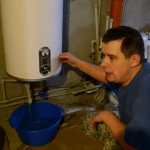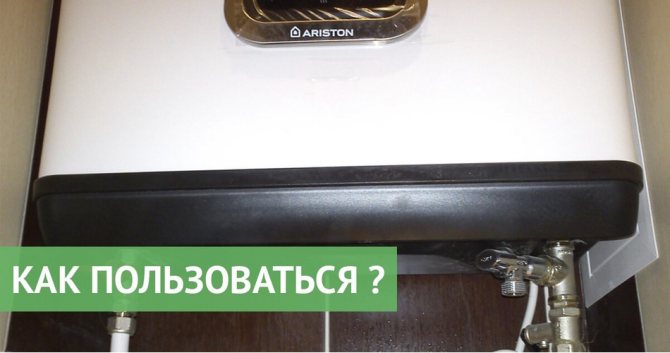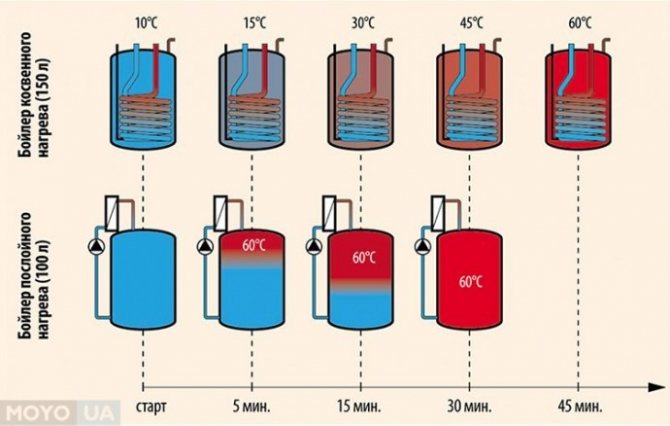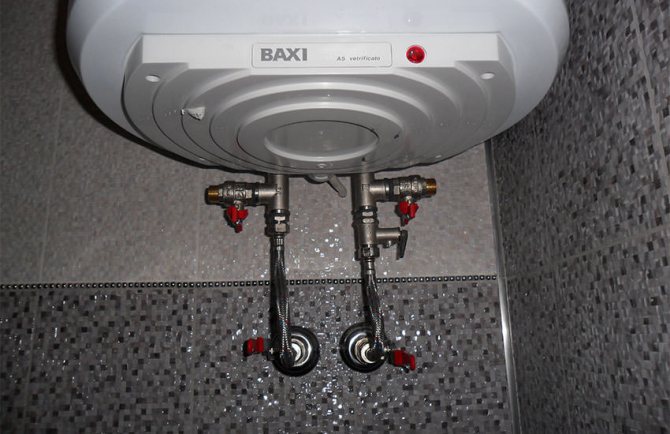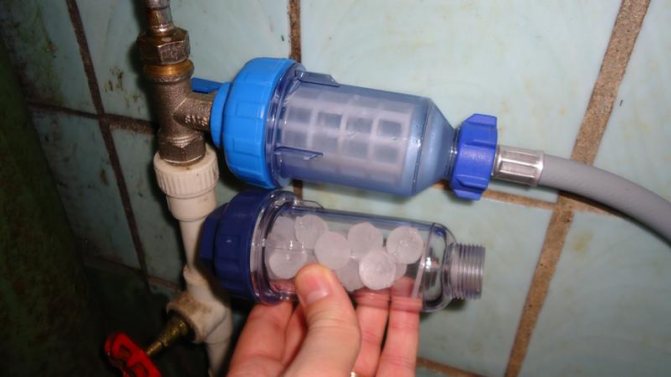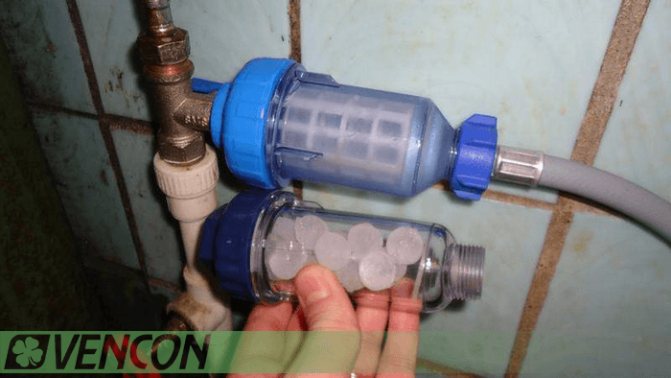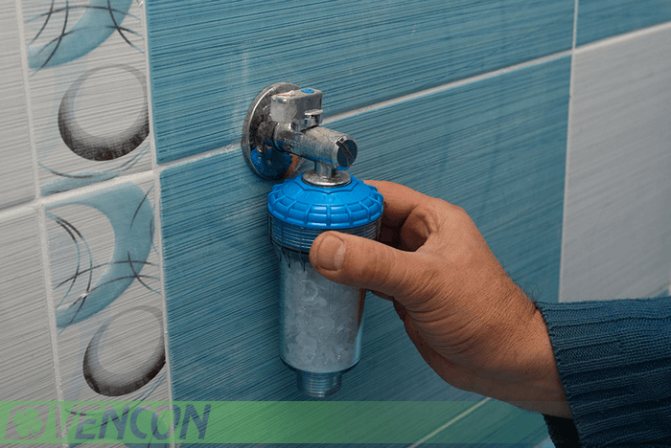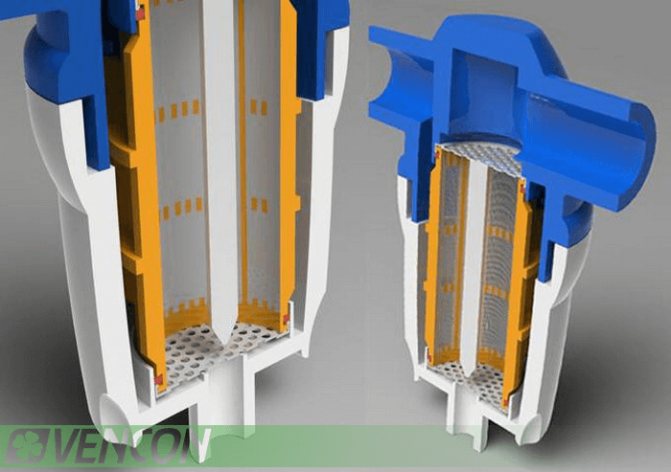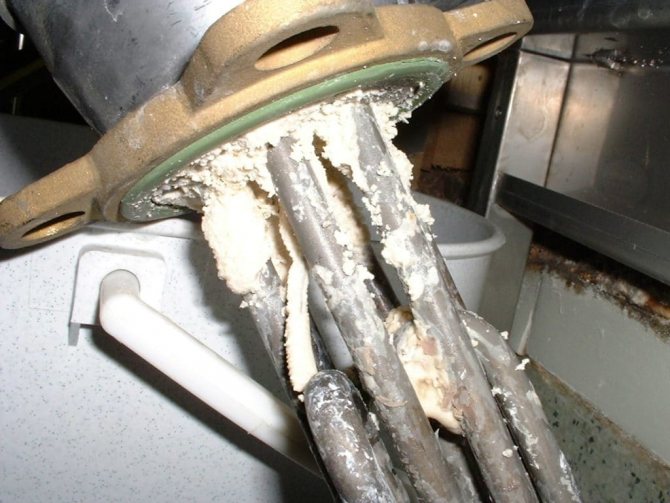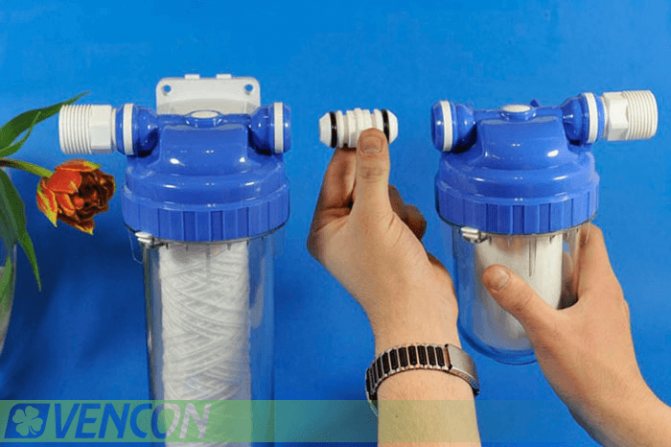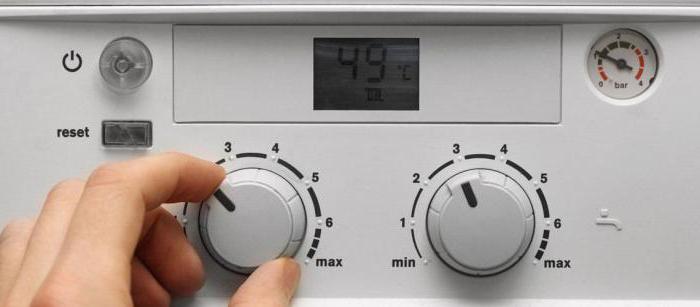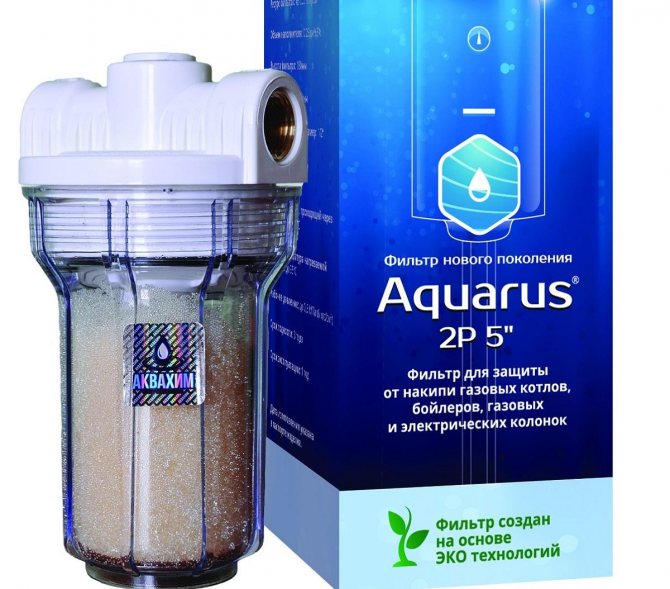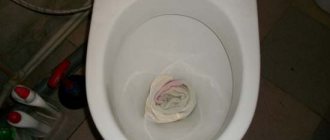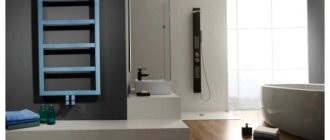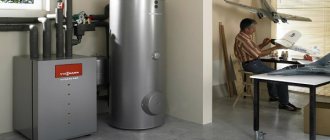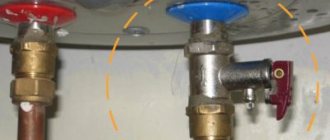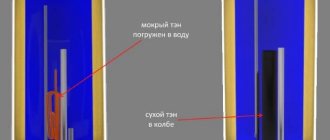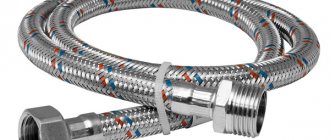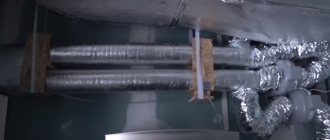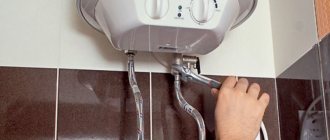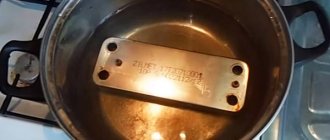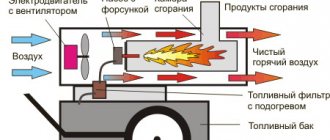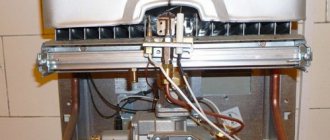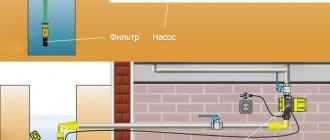In many apartments and private houses, boilers are installed to provide hot water. The service life of such devices largely depends on tap water - if it is too hard, then scale will form on the walls of the internal tank and heating element. This can be avoided by periodically carrying out preventive maintenance, which consists in cleaning the inner surface of the boiler. Experienced professionals know how to quickly and efficiently drain the water from the device. But a person who is faced with a similar problem for the first time needs to first understand all the nuances of the process. How to drain water from a boiler will be discussed in this article.
How to drain water from a boiler
When should the water be drained?
When, in addition to cleaning the inner surface of the tank and the heating element, is it necessary to drain the water from the boiler? This question should be of interest primarily to those who use the water heater irregularly. In country houses, where the owners visit only in the summer on weekends, the water must be drained in cases where the temperature can drop to 5 degrees Celsius during the idle time of the boiler. There is a possibility of the coolant freezing at this temperature and, as a consequence, rupture of the tank in the boiler.
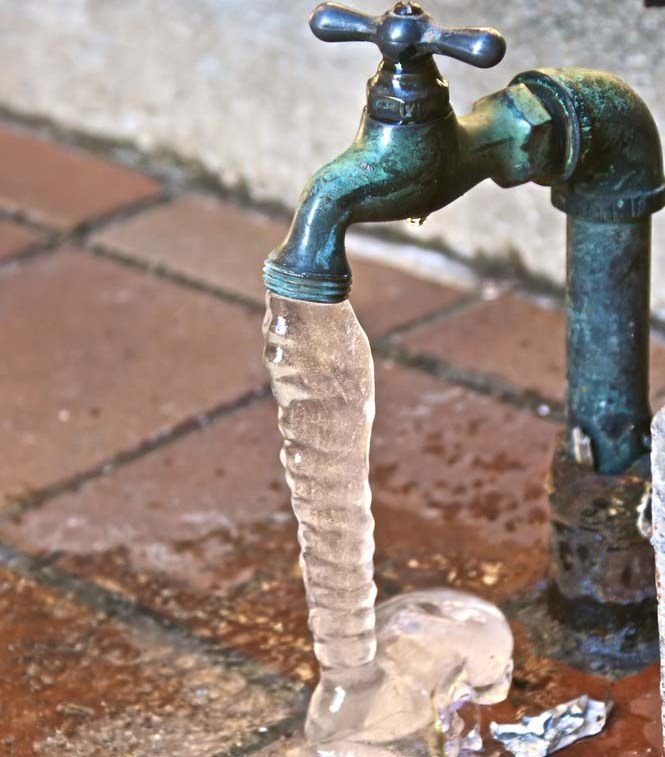
It is impossible for the water temperature in the boiler to fall below +5 degrees
Note! If the temperature does not drop below +5 degrees, then it is better not to touch the device at all, since manufacturers categorically do not recommend leaving water heaters without liquid for a long time. Otherwise, a number of processes may occur that worsen the condition of the storage tank.
Do not be afraid that the water in the tank will deteriorate. After a long "stagnation", it just needs to be passed through the tap, and the next "batch" can already be used. By the way, a magnesium rod works effectively even when completely submerged in water, and perfectly prevents the appearance of rust.
After stagnation, the water must be passed through the tap.
The overwhelming majority of manufacturers also do not recommend draining water often, because a tank without liquid corrodes much faster. Experienced people on this occasion said: a thing created to be in water must be in it.
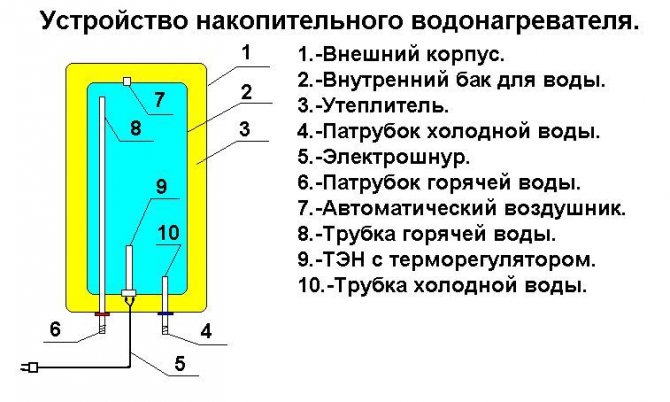

Boiler operation scheme
Often, the drainage of water is motivated by an unpleasant odor that appears inside the device if the water has not been drained for a long time. In this case, you can resort to a little trick: if the pipeline water comes with impurities (such as hydrogen sulfide), then even short-term downtime the boiler should be dehydrated. You can drain water from it every time, and at the first filling, heat it as much as possible.
You may be interested in information on how to clean the boiler
Video - How to get rid of the unpleasant smell of water in the boiler?
Which filter is better to choose
To make it easier for you, we have compiled a selection of filters that users have said well about. Now you will be able to choose which product to supply for the protection against limescale.
Svod-AS
The reagent contained in the flask is called food grade. It does not allow scale to crystallize, so it does not settle on surfaces. In addition, the action of the reagent allows you to remove already deposited plaque.
Suitable for hardness levels: up to 34.
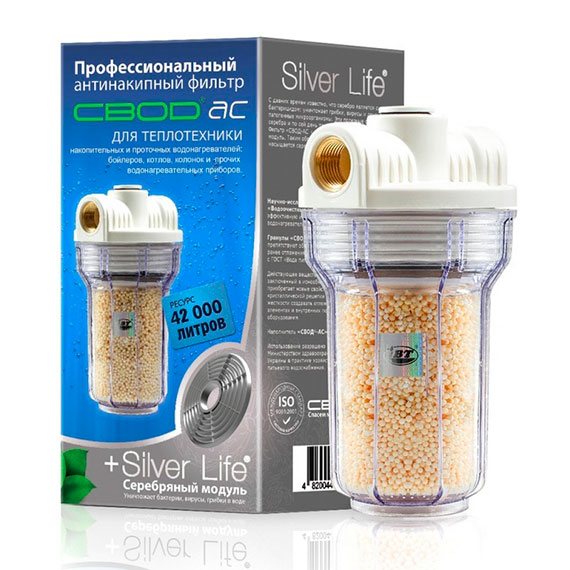

Features:
- Works at a temperature of 105 degrees.
- After purification, water becomes potable and complies with GOST. Can be used safely for domestic purposes.
- Easy to install.
- Replacing the filler is easy.
For example, the Svod-AS 10/250 model is designed for 42,000 liters. Connects to ½ ”thread. Usually installed on a tee.
The Vod 5/100 model has a resource of 15,000 liters and a pipe diameter of ¾ ".
Geyser 1 PF
Installed in front of the water heater.
Works on the basis of polyphosphate salt. Dissolving in water, polyphosphate binds ions of impurities so that they do not precipitate. A transparent flask allows you to keep track of the amount of salt inside.
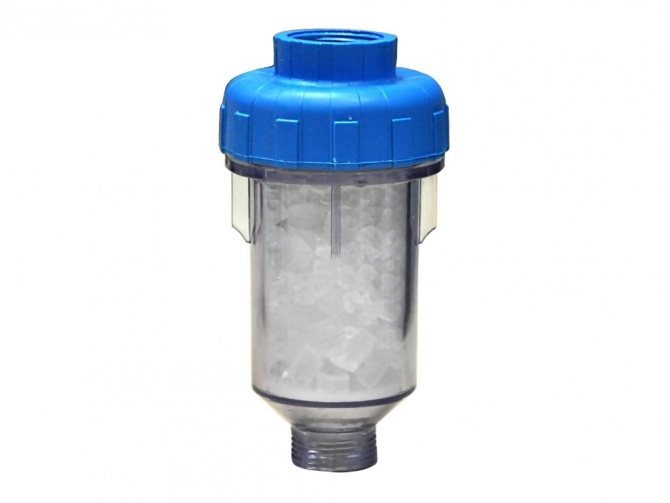

Used to soften water for technical purposes. The productivity is 6 liters per minute. The temperature of the liquid that passes through the filter is 40 degrees. Connects the brine filter to ½ ”threads.
Our Ecozon 200 water
A similar model can be installed in the country or in an apartment. The reagent inside cleans from fine litter: sand, debris. It also neutralizes salt particles, so they do not create limescale deposits. Can be used for boilers, boilers, washing machines and dishwashers.
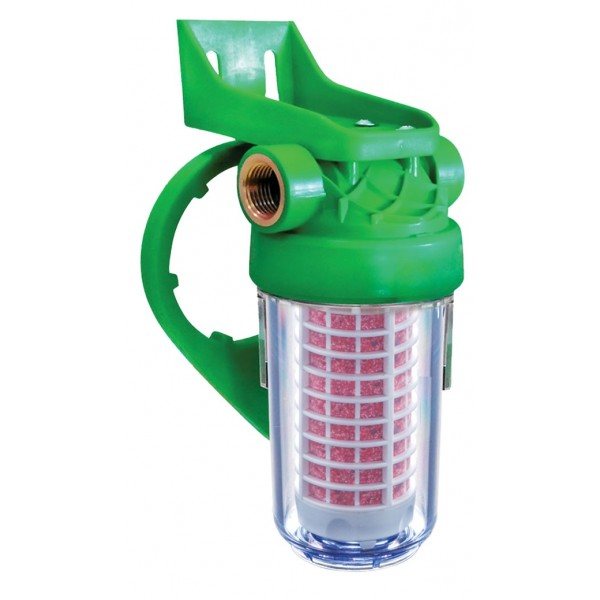

Placed on the trunk line, attaches to thread ¾. The resource is 20,000 liters. The working temperature does not exceed +30 degrees. Does not contain phosphates, therefore it is completely safe for the consumer.
Aquarus 5B
Eco-filter based on new technologies. It is connected to the main line, the flow passes through it and is saturated with an active substance. Reduces the amount of chlorine compounds and heavy impurities. The working resource is 17,000 liters. The throughput temperature is + 5-38 degrees.
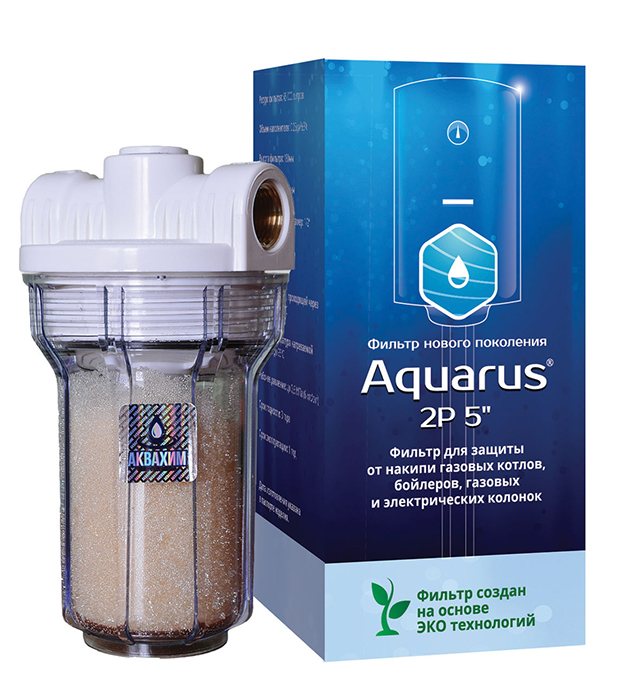

Cristal Policompact
They clean the contents of wells and water pipelines from silt, sand, chlorine, metals, bacteria. However, the water after cleaning can only be used for technical purposes. The composition is changed every six months, and it is not necessary to dismantle the device. Throughput - 3,500 l / h. Temperature - 35 degrees.
What else is useful to install a filter device:
- Cleans pipes from already deposited limescale.
- Provides long-term operation of valves.
Installation is carried out in front of the water heater, for this a tee with a shut-off valve is cut into the pipe. A filter is connected to one of the terminals. Salt replacement is carried out as soon as it darkens or dries up.
Now you can make the right choice. Take care of your equipment and the health of your loved ones, equip the pipeline with cleaning elements. Watch the related video:
How to drain water from a boiler
A boiler is a container that operates at high pressure, therefore, it will not work to drain the water from it by opening the hot water tap and shutting off the cold water supply beforehand. This can be easily guessed if we consider the principle of operation of a storage water heater. If you try to do this, you will only drain the water above the DHW (hot water supply) pipe, and not the fact that completely. It is necessary that air enters the tank - and this is done using the same DHW pipe. Let's see how this procedure will take place.
Perhaps you will be interested in information about if the Ariston water heater has leaked what to do
Step 1. To begin with, the boiler must be de-energized, that is, simply remove the plug from the outlet.
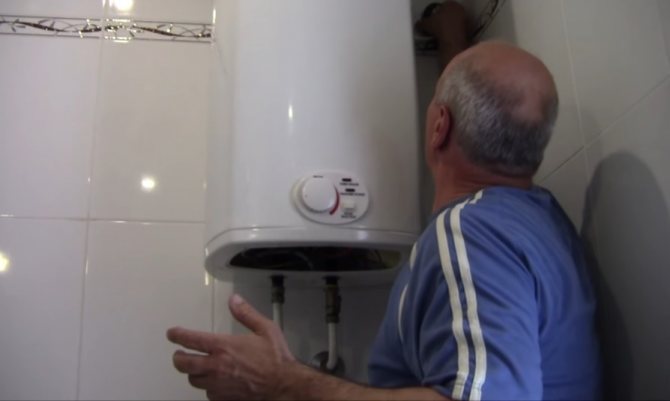

First, the boiler must be de-energized
Step 2. Next, you need to turn off the cold water supply (turn off the tap).
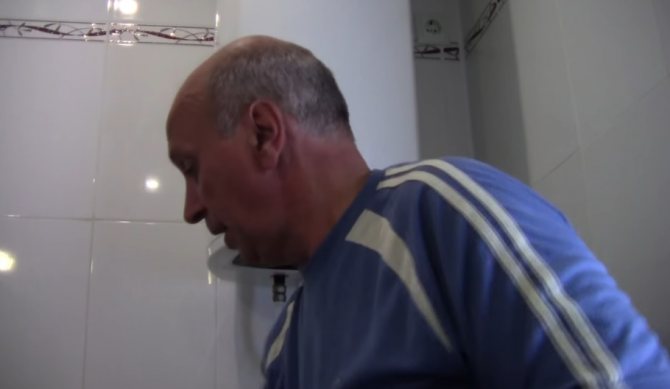

You also need to shut off the cold water supply.
Step 3. Having previously substituted a basin or any other suitable container, you can start unscrewing the cold water pipes. By the way, the connecting pipes that connect the boiler to the water supply and consumption systems can be metal-plastic, just plastic and made of a flexible hose. Craftsmen advise giving preference to metal-plastic products, since they are more reliable, and at the same time look more attractive.
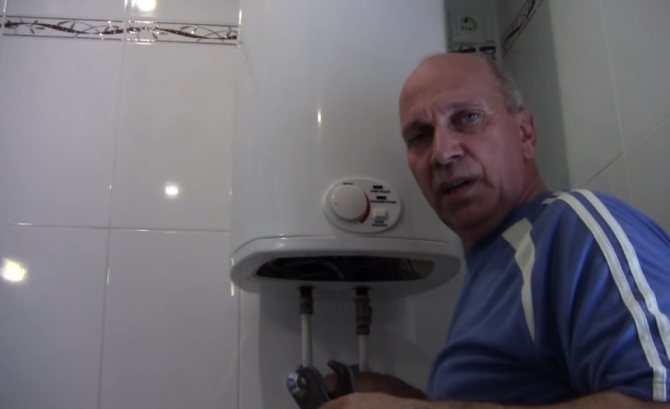

You can start unscrewing the tubes
Step 4. The hose connection points are untwisted, it is released.
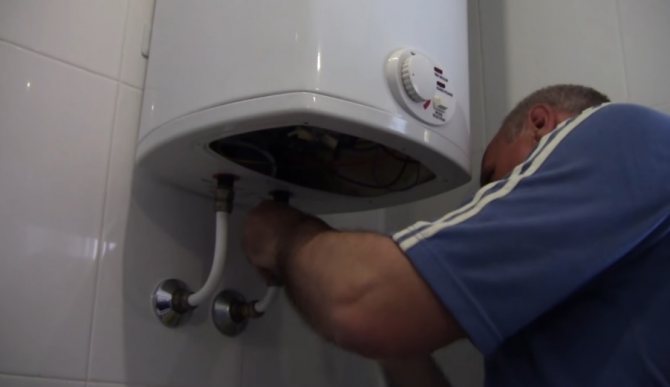

Hose connection points are untwisted
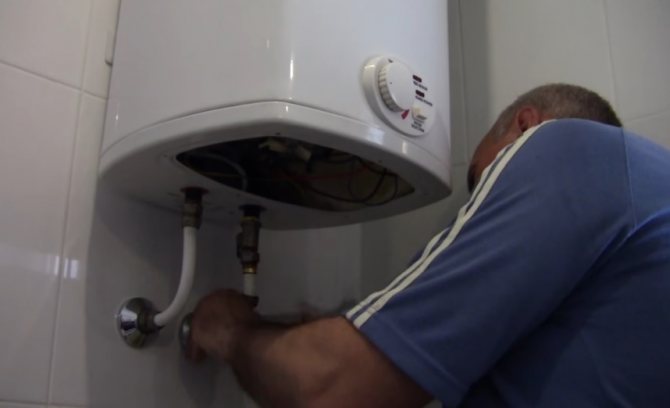

Another photo of the process
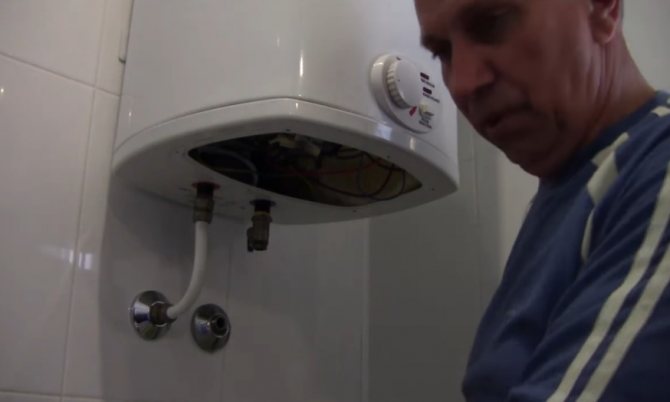

The tube is disconnected
Step 5. The check valve is removed. If in the previous step a little water spilled out, now there will be more of it.This will indicate normal operation of the check valve.
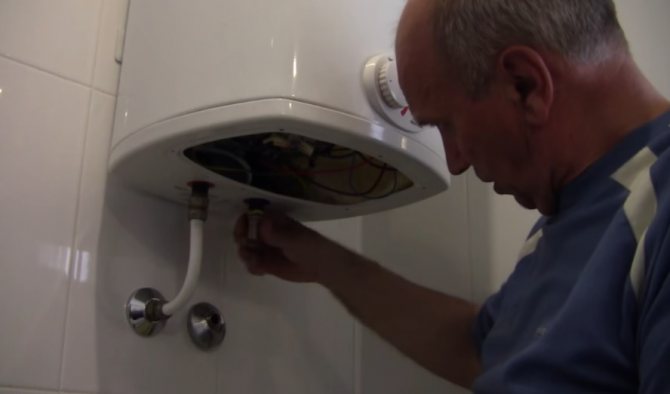

The check valve is unscrewed
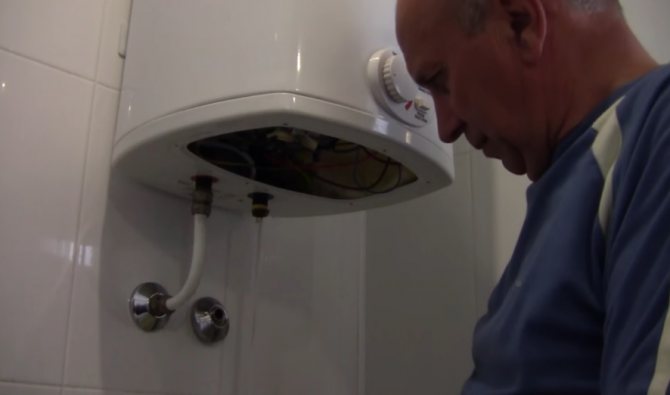

Water flows out of the boiler
Step 6. To proceed further, it is worth dealing with the internal structure of the boiler. So, inside the body there is a tank, which can be all-metal or welded with seams, made of stainless steel or with an enamel coating.
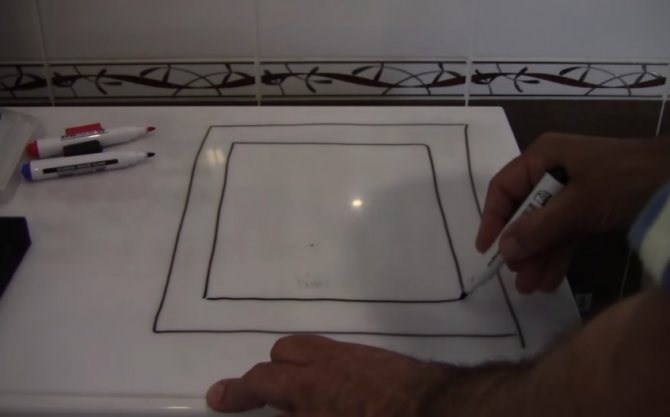

There is a water tank inside the body
Two nozzles go inside the tank: through one of them cold water is supplied to the boiler, and through the other it (already hot) is supplied to an external consumer.
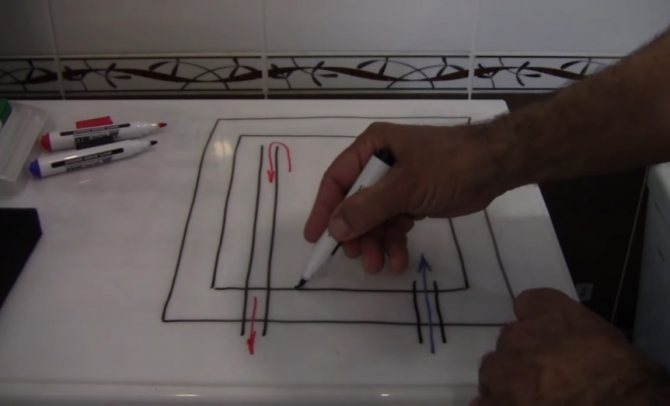

Tubes that go into the tank
Also inside there are heating elements and a magnesium anode (the latter fights scale).
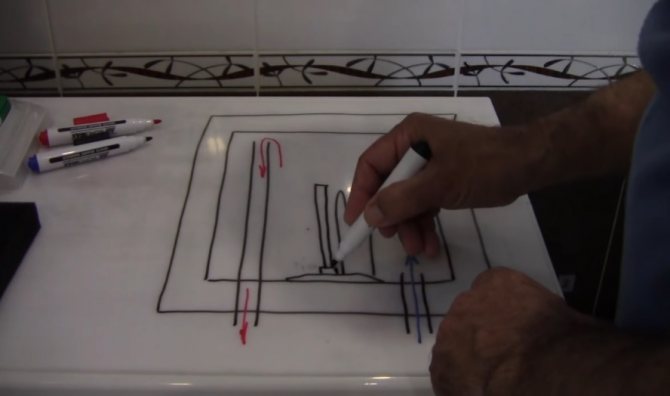

Also inside there is a heating element and a magnesium anode.
In addition, there are two temperature sensor tubes inside. All this goes to the control unit.
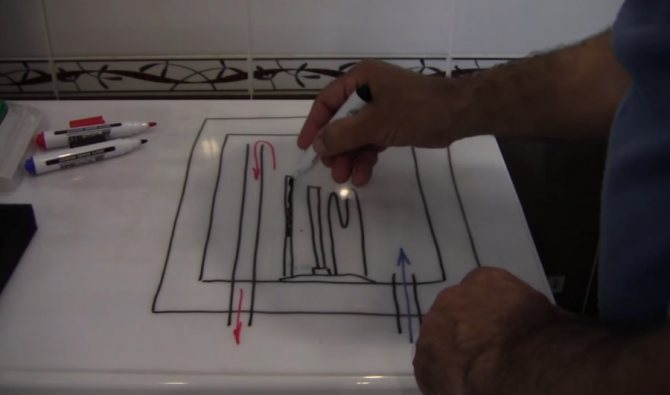

Thermal sensor tube on the diagram
We need the air to enter the upper part and, entering there, give the water the opportunity to come out. Therefore, the more air there is, the more water will go away.
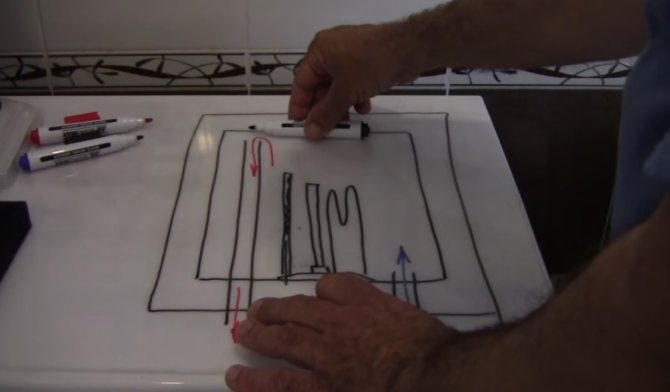

Air must enter the top of the tank
Step 7. The prepared hose is put on the cold water pipe (the basin can be removed). The other end of the hose can be directed into the toilet.
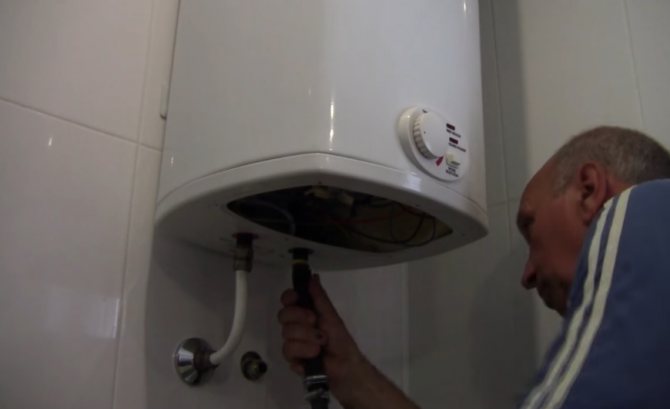

The hose is put on the cold water connection
Step 8. After that, you can unscrew the hot water supply. Thanks to this, air will be supplied directly to the water heater tank.
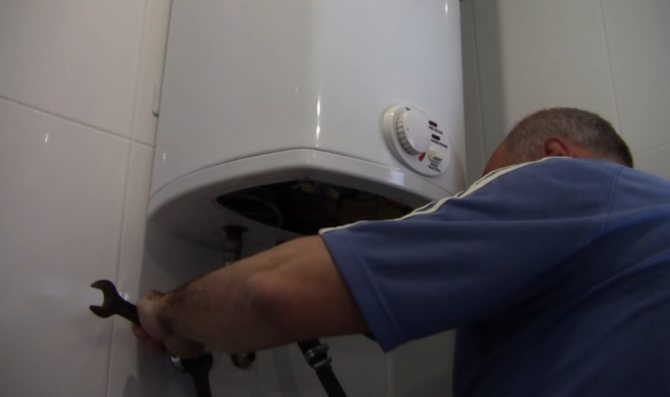

The hot water supply is turned off
Step 9. Air is provided, it is sucked in through the tube and the water is drained into the toilet.
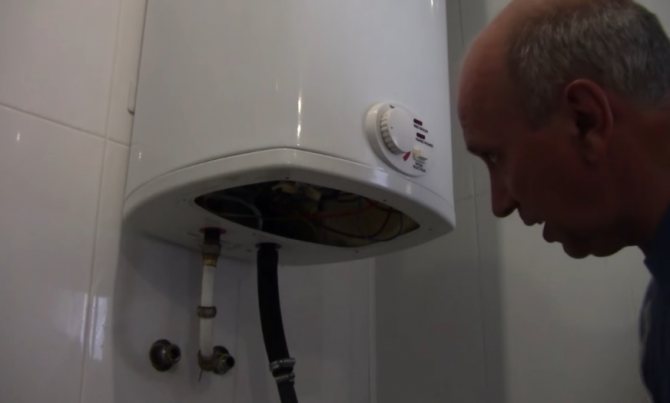

Air is sucked in through the tube, water is drained into the toilet
Note! A small amount of water will still remain in the tank, so later, when you remove the heating element (if necessary), a little of it will fall on your hands. But this is not scary, since the main task - that is, draining the water from the boiler - is practically completed.
The main causes of leaks and methods of their elimination
When the boiler has leaked, the first thing to do is to determine the cause of the leak. There may be several reasons - we tried to list only a few of the most common ones.
Deformation of the case
Deformation of the outer shell of the boiler - such a problem may appear the next day after installation. The fault is not the manufacturer's, but yours, because, as a rule, such a situation arises when they forget to connect the safety valve when installing the boiler. Install it on the water supply line to the product between the shut-off valve and the inlet to the container. It is this small device that protects the tank from overfilling, which leads to deformation: as soon as the tank is completely filled with water, the valve is triggered and shuts off the water supply. As a result, the boiler flows in less than a day.
If the valve was nevertheless installed, but water flows through the supply pipe, then the valve is simply dismantled and a new one is installed - any home craftsman can handle this type of repair, even one who has never received special training.
Deformation could also occur due to the fact that poor-quality pipes were used during the installation of the device. In this case, hydraulic shocks due to pressure changes will be transmitted to the internal container, slowly destroying it.
It will not work to repair the boiler after deformation - the product will have to be changed to a new one, and the connection technology must be carefully observed.
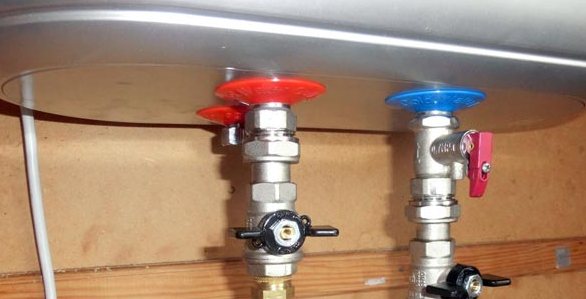

Manufacturing defects
If the source of leakage is somewhere in the upper part of the boiler, but visually no deformation of the container is observed, the magnesium rod was installed when connected, as required by the rules, and it was replaced during operation, then a factory defect may occur. If the product is under warranty, then it is necessary to return it to the selling organization before you flooded the neighbors below.
Modern water heaters are designed in such a way that the tank cannot be repaired, it is impossible to weld it: when using welding, the enamel layer around the hole is broken, corrosion will form, corroding the container in another place. The cost of repairs in this case is almost equal to the price of a new boiler, and the modifications made to the appearance of the repaired product will not decorate the interior of your bathroom.
Spent heating element
If water leaks from under the storage tank lid of the product, it is most likely that too much scale has accumulated on the heating element and needs to be replaced. First of all, you need to purchase a similar heating element in the store of spare parts for water heaters, dismantle the old one, clean the inner surface with ordinary vinegar and soda - this mixture corrodes any scale well.
Together with the heating element, a special magnesium rod is also changing.
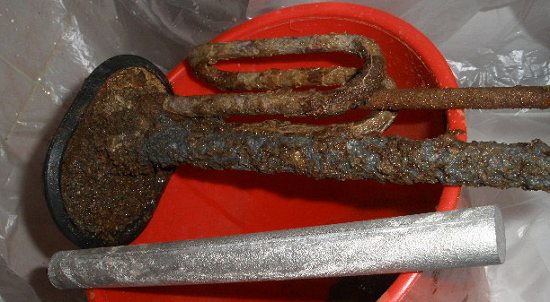

Poor installation of the device
Fluid may leak from under the heating element o-ring - try tightening the nuts tighter to stop the leak. Sometimes a leak is formed along the mounting bolts of the heating element, with such a development of a negative plot, you will have to buy a new heater - welding cannot be used, because warpage of the thin walls of the inner container will occur.
A common reason for the formation of smudges on the pipes for entering cold and leaving hot water is a loose connection. This is often the case with do-it-yourself installation, if the wrong sealing materials or poor quality fittings are used.
Gasket wear
When water flows through the inspection hole in the plastic cover on the bottom of the water heater, most likely the rubber gasket on the flange has lost its elasticity. To determine this for sure, you need to turn off the device, remove the bottom cover and visually establish the cause of the leak.
If the fault of the gasket is installed, then you just need to replace it. In the store we purchase a strictly similar one - when buying, tell the seller the model number of your boiler so that the new product fits perfectly.
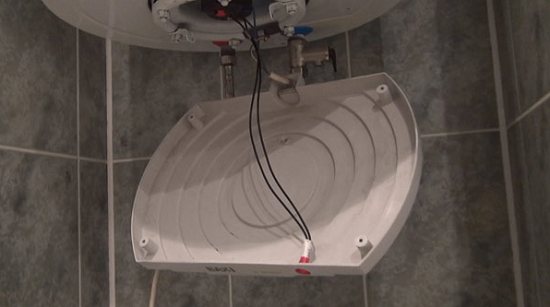

How to remove residual water from the water heater?
As noted above, after draining the water, some of it will still remain inside the tank. And to completely empty the tank, you will need to remove the heating element. To do this, you can follow the algorithm below:
- remove the special casing, having previously disconnected all electrical components;
- once again substitute a basin or any other container designed to collect dirty liquid and debris;
- unscrew the heating element. You may have to make a lot of effort, since in the manufacture of boilers, heating elements are screwed very tightly. Then, after removing the heating element, the water will immediately start flowing into the basin.
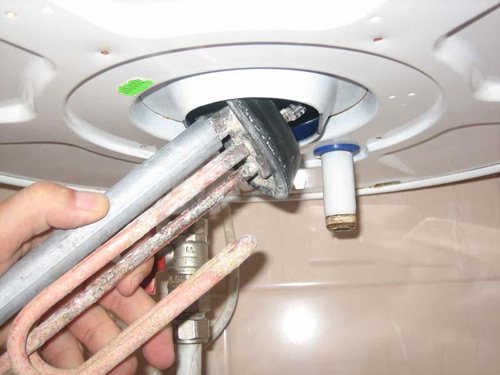

Any owner can replace the heating element
Of course, it is better to consider the possibility of the need to drain the water and make all connections collapsible. And if the water needs to be drained often, then it is advisable to install tees on the supply / drain of the device (tees should be with taps to drain the water).
Video - How to drain water from a water heater, boiler
Note! Due to the fact that the cold water supply pipe still has some height, water will still remain in the tank (out of 100 liters - no more than 10-15), even if it seems that all the liquid has already been drained. This must be taken into account if the boiler is not planned to be used in winter. To get rid of all the water, you need to unscrew the heating element and drain the water through the mounting hole.
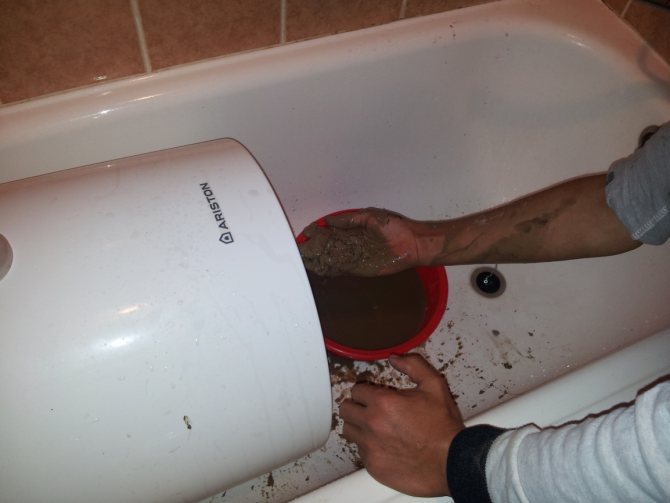

For complete cleaning, you need to remove the heating element and drain the water through the mounting hole
Do I need to install a water filter for the water heater
With hard water, scale forms in the water heaters, which in turn will lead to a decrease in efficiency and then to a breakdown of the heater.It is possible to fight scale with several methods. first: as you already said, the filter or as they are called, water softeners, we will get rid of the cause of scale formation to a greater extent. second: it is the use of magnetic polarizers. The result is the same as for the filter. third: it is proved that at a temperature of 80 degrees, 7 times more scale is formed than at a temperature of 60 degrees. So, heat the water up to a maximum of 65 degrees. There are also storage water heaters, they are designed specifically for hard water. In such a system, there is no problem of scale, but in my opinion, the efficiency is lower.
You definitely need to install a filter, as your water heater will not live long without it. I had a similar situation with the boler, which flew literally half a year later, and when the craftsmen came and took it apart, I was shocked by how much scale there was, so put the filter on without fail.
According to experts, there are two problems that the water heater is afraid of: scale (a water filter or periodic cleaning of the heating element can cope with this problem) and wiring (installing a water heater can create a "critical situation"). To solve this problem, two types of filters are installed: coarse filters and fine filters. Coarse filters are necessary for preliminary purification of the water supplied to the apartment from rust, sand and other foreign objects. Such filters have a mesh installed inside, the mesh size of which is up to 500 microns. Filters are installed after shut-off ball valves in order to always be able to shut off the water supply and clean the filters. Fine water filters provide a continuous supply of filtered water, preventing the penetration of foreign bodies into the mains, in particular, rust particles, hemp fibers, grains of sand, etc. These particles accumulate on the filter screen and the bottom of the bowl and can be easily removed by activating the rinsing mode. During the flushing process, the water flow passes through the mesh, rinses it from the inside and, capturing debris at the bottom of the flask, is removed either into a substituted container or into the sewer. Flush mode is turned off by simply turning the ball valve knob. These filters are equipped with a mesh with a mesh size of 50 µm or 100 µm. It must be remembered that the filter should be installed only with the tap down.
tiger27, a mechanical water filter does not solve the problem of limescale in any way. Salt precipitation usually occurs when water is heated or in contact with air. We have water with a hardness of 8 meq / l. We heat water with a gas column, we do not use any filters. The first column has served for 30 years, the second is already more than 10, it works properly. I think if your hardness is at the same level, then you should buy an instantaneous water heater, then there will be much less problems.
When you DO NOT need to drain the water
The water from the boiler does not need to be drained if it is out of order during the warranty period. Contact the service center immediately - they should look for the cause and eliminate the malfunction. In most cases, boilers are repaired at home, like any other large equipment.
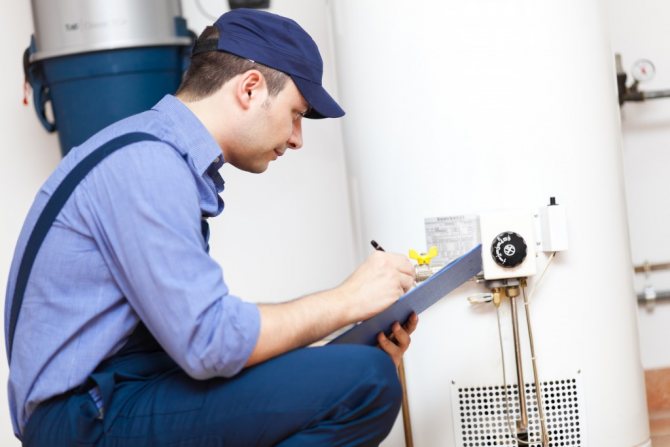

Boiler warranty repair
Cleaning the water heater
Citric acid, which is so great at removing limescale in an electric kettle, would certainly do the trick here. But feeding it into a boiler or tank is much more difficult than pouring it into a kettle. And it is sometimes simply necessary to clean a water heater that has worked for some time without a filter or during the replacement of the latter.
Dismantling, disassembling and washing by hand means spending a lot of time and effort. But there is another way out. In specialized stores, you can find a cleaning system that can be easily connected to the heat exchanger.They are designed in such a way that after connecting, it remains only to heat the reagent contained inside, which the water heater itself will do, turn on the circulation and then drain the water.
After that, you can safely install the filter and enjoy clean water at any time of the year, regardless of the preventive and emergency work of public utilities. The main thing is not to forget to periodically look at the state of your water-purifying assistant and to do preventive measures for him in time. He, in turn, will ensure long and trouble-free operation of your boiler.
Why is it necessary to install filters?
The water contains such substances as: salt, magnesium, calcium. It is because of these compounds that it becomes rigid, and plaque forms on the walls of the devices. In order to purify the water from all kinds of contaminants, bacteria and viruses, filters are installed.
By installing a water purification filter, you will significantly increase the life of your water heater.
Polyphosphate water filter
Also, one of the "enemies" of water heating devices is scale. It appears due to the fact that hard water heats up. At the initial stage of its appearance, this sediment resembles a light limescale, it interferes with the conduction of heat, as a result of which it takes more time to heat the liquid in the boiler.
If you do not clean it at the initial stage of contamination, then the layer of plaque will become thicker, and the water will warm up for an even longer time. Often, at the very first stage, water with pieces of scale is released from the water heater. If you notice such formations, then the device needs to be urgently cleaned.
